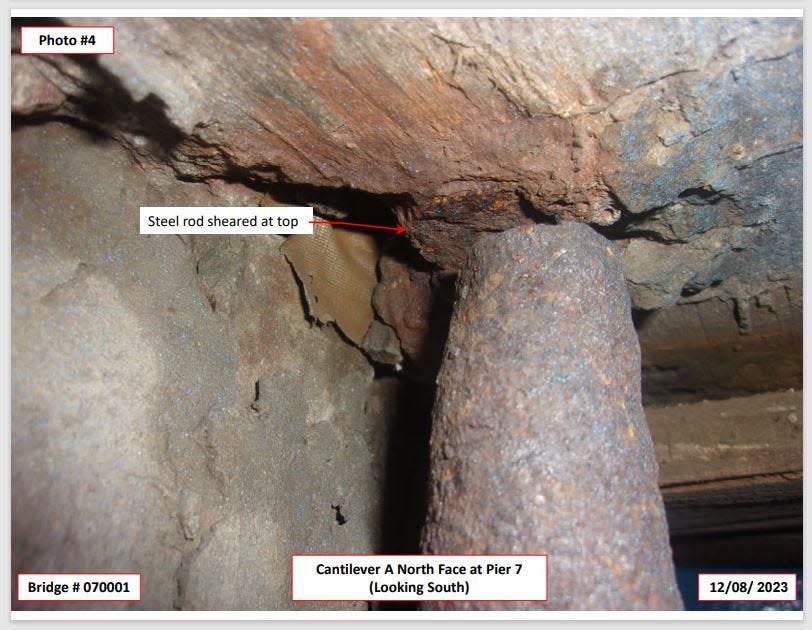Broken bridge parts and specks of blue paint. How long was bridge at risk before closure?
PROVIDENCE − State transportation officials spotlighted the importance of broken tie-down rods when they closed the Washington Bridge's westbound lanes on Route 195 on Dec. 11, citing the potential for a catastrophe.
More than two months later, it still isn't clear how long the rods had been broken.
Appearing at an oversight hearing on Monday, Peter Alviti Jr., director of the state Department of Transportation, told state lawmakers that various "forensic" analyses, which are already underway, can answer such "look-back" questions.
One such investigation, launched by the U.S. Department of Justice, is looking at "the pins themselves to track their history to see what happened," Alviti said.
Timeline of the Washington Bridge: Here's how it all happened
In the meantime, specks of bright blue paint make for a tempting line of inquiry.
The paint specks are visible in a DOT photograph of one of the broken tie-down rods, which Alviti refers to as "pins." The tiny blue dots are on a surface of the rod that was exposed when it broke. Obviously, for such paint globules to come to rest on that particular surface, the rod had to be broken at the time the paint was applied.
So if DOT does not know when the rod was broken, does the agency know when the broken rod was exposed to the paint?

The origin of the paint specks isn't mysterious
Another photo, which also has a December date on it and which DOT posted online, shows the same rod in proximity to nearby steel bridge components. Those components are painted blue, and the blue hue of those nearby components matches that of the specks on the broken surface area of the rod.
So when were the nearby bridge components painted?
DOT: bridge components painted 'between mid-October and mid-December.'
The DOT photo itself says the tie-rod in question is at Pier 7.
In a Feb. 7 email exchange, DOT spokesman Charles St. Martin III said that components "in the span near piers 6 and 7 were painted between mid-October and mid-December."
In response, St. Martin was asked if the department couldn't narrow down the timeframe of the work to less than three months. He has not replied.
The timeframe that St. Martin provided for the paint work runs right through the bridge shutdown during the first half of December.
Under that timeframe, the paint specks could have appeared on the broken rod just before DOT distributed the close-up photo of the broken rod.
In that scenario, the blue paint specks are not evidence that the tie-rod was broken for months as vehicles drove over the bridge millions of times.
Oversight hearing sheds light on bridge painting process
At Monday's hearing, lawmakers heard from Jeffrey Klein, the director of structural engineering at a firm that reported the bridge issues to DOT in December.
State Sen. Samuel D. Zurier asked how the company, Vanasse Hangen Brustlin, decided to look at the span "at that time" in December.
Klein told him that a contractor "was doing some painting work as part of the design-build activities."
"We were out there," Klein said.
VHB, Klein said, needed to determine if "any additional steel repairs" were necessary "after that painting activity."
Klein's comments added some additional context regarding painting on Span 7.
But it's still not clear when the broken tie-down rod became a speckled tie-down rod.
With reports from Journal staff
This article originally appeared on The Providence Journal: How long was Washington Bridge damaged? Paint flecks might provide clues

